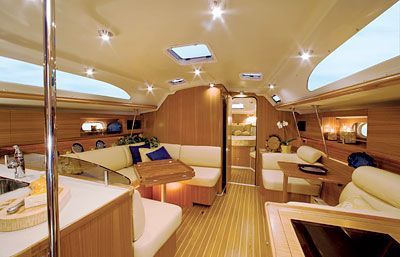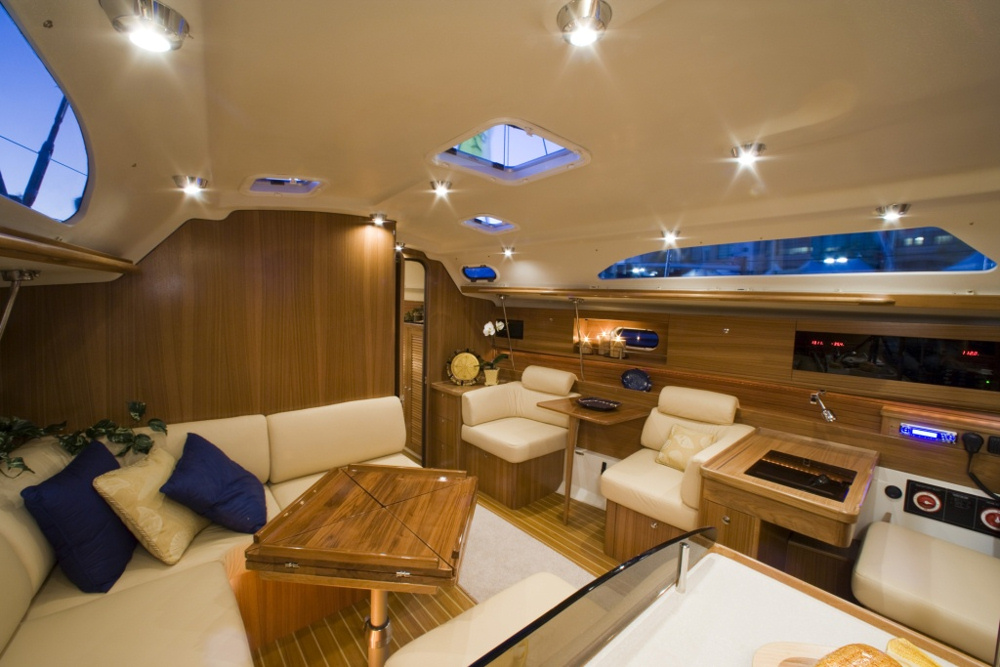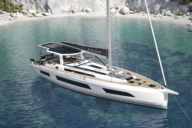At first sight you know there is something different about the new Catalina 445. The design’s topsides appear lower than her sister ships and the cabin top has a lower profile. The cockpit is large and has twin wheels and throughout the cabin the moldings are more angular, more modern than we have seen from Catalina before.
This is the next generation Catalina and it has been created to be a fine liveaboard home, a sweet sailing, offshore-quality boat and an excellent, long-term value for its owners.
BWS joined Catalina’s V.P. Gerry Douglas, who designed the 445, aboard the new boat in Oakland, Calif., for a test spin on San Francisco Bay. The boat had just premiered at the Strictly Sail Pacific boat show to a very warm reception from dealers and potential customers.
Gerry took the helm, we cast off the mooring lines and he then backed the new 445 out of the slip and turned for the channel. The new boat maneuvered easily and surely and had enough horsepower to cruise at 6 knots with only 1,800 rpm showing on the tachometer.
The boat was equipped with a roller furling headsail and an in-mast roller furling mainsail which make sailing the new boat a breeze. Unfortunately breeze was the missing element in our cruise of San Francisco Bay. But that didn’t stop us. We tried the genoa for a while and then opted to roll it up and launch the new Screecher, which is a fairly flat cut reaching sail on its own free-flying roller furling system.
The Screecher did the trick so we were able to reach away from the Oakland shore and out into the bay toward the Bay Bridge. It was a glorious spring Monday and we were slipping along nicely in the 80-degree sunshine.
The Design
The new 445 is an evolutionary design for Douglas and Catalina. The hull is finer and slipperier than it’s nearest Catalina cousin, the amazingly durable Catalina 42. The hull’s design numbers tells us a lot about the parameters of the boat. The sail area-to-displacement ratio is 18.1, which is higher than most other production boats in this size range and indicates that the boat has been spec’d out and rigged for better than average sailing ability and speed. (The SA/D is a measure of a design’s “power to weight” ratio.)
The displacement-to-length ratio of 165 indicates that the 445 is fairly light but still in the middle range of boats in this size range. The DL offers a ratio that allows you to compare boats and predict their quickness and speed capabilities. The lower the ratio, the lighter the boat. By way of comparison, the Beneteau 43 has a DL of 126 (quite light) while the Tartan 43 has DL of 234 (moderate).
A design’s ballast ratio shows you what percentage of the overall displacement is contained in the ballast and keel and thus how resistant it is to heeling. The ratio can range from 25 percent in traditional cruisers to nearly 50 percent in high tech racing machines. The 445’s ballast ratio is quite high at 39 percent when compared to other boats in its class; this gives the boat a very solid feel beneath you and allows it to stand stiffly to the breeze when sailing upwind. It is worth noting that Catalina still uses lead in its keels and has not switched to cast iron.
We did not put the 445’s numbers to the test during our sail on San Francisco Bay but we did discover that the new boat is slippery in a light breeze, and that it is both fun and easy to sail.
ON DECK
The cockpit and deck layouts are very well thought out with short-handed crews in mind. The primary sheet winches are large multi-speed winches and placed near the aft wheels in reach of the helmsman. The twin wheels are positioned to enable the helmsman to see forward from the neatly elevated seats port and starboard; the steering linkage between the wheels and rudder are smooth and offer a very good touch at the helm.
The cockpit is large and roomy with a folding table that will seat six for a meal. There is a swiveling pod built into the aft end of the table for the chartplotter so you can see the screen from both sides of the boat.
Storage for sails, lines and gear has been provided in three good cockpit lockers, two aft and one under the starboard seat. The port cockpit seat is a “gull-wing” molding that flips up to reveal a large hatchway into the aft port cabin. This will be particularly useful when the cabin below is being used as a storage locker.
The running rigging is set up for cruising in all weather. The mainsheet traveler on the cabin top is fully adjustable so you can power up or de-power the sail as the wind gusts. The traveler control lines both run to jammers on the port side of the cockpit. The genoa sheet tracks on the side decks are extra long, which will permit you to trim a reefed genoa accurately by moving the cars forward or trim a small storm jib when the wind really picks up. Few production boats offer this detail.
With halyards and reefing lines led aft on the cabin top to winches on either side of the cockpit, you will be able to handle all sail trim tasks from the cockpit; and, with a dodger rigged, you can stay dry and out of the wind while doing so.
Catalina has always maintained close relationships with the owners of their boats so they benefit from a lot of feedback from those who are actually out there sailing and cruising. This feedback leads to a lot of useful details in each new design. On deck on the new 445, you will find handholds and rails just where you will need them when underway. You will find an anchor locker forward that is equipped with a large electric windlass and ample room for anchors, rodes and a secondary anchor. And, you will note the 27-inch lifelines that add to safety and security while you are working on deck while sailing.
FLEXIBLE ACCOMMODATIONS
The 445 was designed for a couple who will be cruising on their own but will often have friends and family join them. The accommodation plan has been tailored to meet these specific needs with a large master cabin forward fitted out with a centerline double berth and its own head and a second double cabin aft to starboard with a second head. Both heads are relatively large and the forward one has a separate shower stall.
The port aft cabin has been created as a flexible living space that can accommodate three different uses. Without the need for fancy tools, you can have either a double berth or upper and lower single berths. Or, if you do not have guests aboard, you can convert the cabin into a workshop and storeroom. BWS has not seen a production boat with such a flexible cabin and we think it is a great idea.
The saloon has the large galley to port. The twin sinks are nearly on the centerline so they will drain on both tacks; the front loading fridge faces aft so it doesn’t disgorge its contents when the boat heels or rolls; the three-burner, gimbaled stove has a cutting board top that you can use as a level surface even when the boat is heeled over or rolling; and, there are large storage lockers and rack space for all of the supplies, cutlery and dishes you will need.
The chart table to starboard has been designed to fit regular ChartKits on top and to neatly store a laptop computer inside. A pod at eye level can be designed to house a chartplotter. Radios and other instruments can be installed in the large cabinet outboard of the table. This is a very modern and attractive nav station that will appeal to experienced sailors who will appreciate the fact that it faces forward.
The dinette to port has a folding table that converts from a low coffee table to a large dining table that will seat five or six. The dinette can also be converted into double berth.
To starboard the split settee is long enough to be a sea berth and will be favored in heavy weather since it is right over the boat’s center of gravity. A small table folds up in the middle of the settee, which will be useful for playing cards, holding drinks or just for reading.
The décor and finish of the 445 is modern without being trendy. The furniture is teak veneer with solid teak corners and framing. The doors and drawer fronts are solid teak with hand joined handles and louvers and high quality stainless steel latches and hinges.
The floors, which are all on one level so you don’t trip, are teak and holly patterned laminate that is both attractive and easy to keep clean. You can tell the 445 was designed and built by sailors for sailors because there are hand holds everywhere and fiddles on the tables and around the galley counter.
UNDER THE HOOD
The engineering and systems aboard the 445 are all well thought out and of high quality. The engine compartment under the companionway ladder is very accessible so you can get right in there to perform routine maintenance. The filters for the engine are all grouped to starboard and are easily reached and changed through a special compartment in the starboard aft cabin.
Auxiliary systems such as a watermaker, air conditioning or a genset can be fit into the spaces under the berths in the aft cabins or in the large lazarettes aft so they will be easy to get at and work on. The hot water heater nestles beneath the navigator’s bench and the two 8D batteries (440 amp hours) fit into a battery compartment just forward of the engine.
The standard Yanmar 54-horsepower engine will drive the boat at hull speed and can maintain a cruising speed of 7 knots at very efficient rpm. With 66 gallons of fuel, the 445 will have a motoring range at 6 knots of nearly 700 miles—enough to motor from Newport to Bermuda.
Both heads have their own holding tanks, which have been built in the head compartments above the waterline so they will drain when the overboard seacocks are open. This is a convenient set up for coastal cruisers who regularly sail in the ocean. The tanks also can be emptied with shore side pump out facilities.
The installation of the electrical systems, water systems and electronics are all to ABYC and IMIC standards and recommendations so you know you can rely on them for the long term
The new Catalina 445 is an attractive and innovative addition to the Catalina fleet. The boat will serve well as a long haul cruiser whether along the coasts or across oceans. And those who want to live aboard for any length of time will find that the boat is big enough and comfortable enough to be a great floating home away from home. Plus the 445 offers its owners excellent value that will continue to hold its value for years to come.
CATALINA 445
LOA 44’5″
LWL 38’4”
Beam 13’7”
Draft (std) 4’10”
Draft (deep) 6’11”
Displ. 20,000 lbs.
Ballast 8,000 lbs.
Fuel 66 Gals.
Water 182 gals.
Waste 54 gals.
SA/D 18.1
DL 165
B/D 39%
Catalina Yachts
Woodland Hills, CA
and Largo, FL
Ph: 818-884-7700
Ph: 727-544-6681
www.catalinayachts.com















